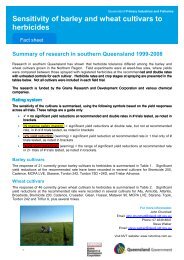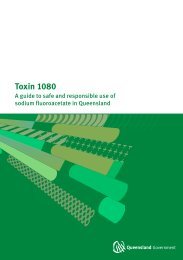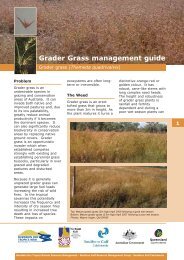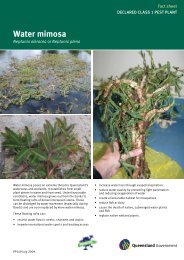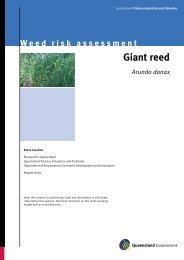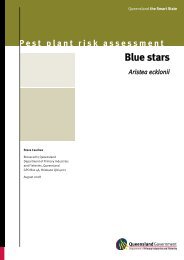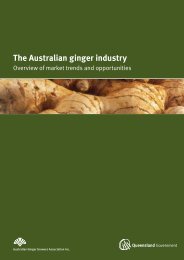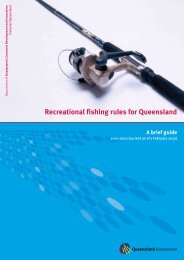To net or not to net - 3rd edition - Department of Primary Industries
To net or not to net - 3rd edition - Department of Primary Industries
To net or not to net - 3rd edition - Department of Primary Industries
Create successful ePaper yourself
Turn your PDF publications into a flip-book with our unique Google optimized e-Paper software.
Figure 35. Nets over a polypipe hoop tunnel that have been lifted and joined <strong>to</strong> the wires on the shoulder<br />
<strong>of</strong> the adjacent row <strong>of</strong> hoops<br />
<strong>To</strong> make joining the lengths <strong>of</strong> <strong>net</strong>s quicker, the <strong>net</strong> can be pulled between double wires and clipped<br />
on <strong>to</strong> the wires at +/– 1 m <strong>to</strong> intervals using cable clips. A pole and spreader arm arrangement can be<br />
constructed in a similar way <strong>to</strong> the coathanger tunnel <strong>net</strong>ting frame (Figure 36).<br />
Figure 36. A schematic representation <strong>of</strong> a system <strong>of</strong> poles and spreader arms <strong>to</strong> hold temp<strong>or</strong>ary <strong>net</strong>s<br />
above the canopy (drawing courtesy Oblimov Trading Company)<br />
Microclimate, tree growth and management<br />
Changes <strong>to</strong> microclimate<br />
Permanent canopy <strong>net</strong>ting changes the microclimate and environment under the <strong>net</strong>. Changes <strong>to</strong> the<br />
<strong>or</strong>chard microclimate will be significantly greater where <strong>net</strong>s with small mesh sizes (such as a 12 mm<br />
quad hail <strong>net</strong>) are used than where <strong>net</strong>s with large mesh sizes (such as a 37 mm <strong>or</strong> 20 mm mesh flying fox<br />
exclusion <strong>net</strong>) are used. Net colour also influences the changes that occur.<br />
Two research projects have provided some data on the effect <strong>of</strong> <strong>or</strong>chard <strong>net</strong>ting on the environment under<br />
the <strong>net</strong>.<br />
Project 1—Research on hail-<strong>net</strong>ted apple <strong>or</strong>chards in Queensland, New South Wales and Vict<strong>or</strong>ia<br />
(Middle<strong>to</strong>n & McWaters 1996, 2000) studied the changes <strong>to</strong> the under-<strong>net</strong> microclimate. It was found that:<br />
•<br />
•<br />
•<br />
•<br />
•<br />
Light levels, assessed by measuring pho<strong>to</strong>synthetically active radiation, were reduced by 20–27%<br />
under black <strong>net</strong>, 18% under grey <strong>net</strong> and by 12–15% under white <strong>net</strong>.<br />
Humidity was consistently increased by up <strong>to</strong> 10%. After rainfall the humidity under the <strong>net</strong><br />
remains high and takes longer <strong>to</strong> fall than under non-<strong>net</strong>ted trees.<br />
Hail <strong>net</strong> had a minimal effect on air, grass <strong>or</strong> soil temperature. On warm <strong>to</strong> hot days air<br />
temperatures under the <strong>net</strong>, measured in a Stevenson screen, were reduced by 1 °C <strong>to</strong> 3 °C when<br />
compared <strong>to</strong> rec<strong>or</strong>dings in a Stevenson screen outside the <strong>net</strong>. The Stevenson screen excludes<br />
radiation and restricts wind, permitting a ‘true’ measure <strong>of</strong> air temperature. The temperature<br />
under black hail <strong>net</strong> may ‘feel’ cooler because light levels are reduced. The temperature under<br />
white <strong>net</strong> may ‘feel’ higher on hot days because <strong>of</strong> reflected light <strong>of</strong>f the <strong>net</strong>.<br />
Wind speed is reduced by up <strong>to</strong> 50% within the <strong>net</strong>ting.<br />
Hail <strong>net</strong> has little effect on night time temperatures and does <strong>not</strong> <strong>of</strong>fer frost protection.<br />
20<br />
<strong>To</strong> <strong>net</strong> <strong>or</strong> <strong>not</strong> <strong>to</strong> <strong>net</strong>





